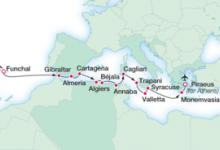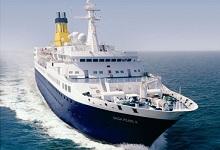Recently Viewed Cruises
- Quest for Adventure, Relics of Byzantine Empire ex Funchal to AthensAdd to favourites
- Mariner, The Grand Atlantic ex Miami to BarcelonaAdd to favourites
- Wind, Voyage 2307 ex Lisbon to RomeAdd to favourites
- Divina, Pillar of Hercules ex Genoa to VeniceAdd to favourites
- Quest, Semana Santa in Seville ex Seville to BarcelonaAdd to favourites
- Royal Caribbean International raises the bar
- Classy Astor fills gap in market
- Oceanic Discoverer
- Ab Fab Oosterdam
- Catch up on Cruising: Latest cruise news in bite size
- Frequently Asked Questions
-
Quest for Adventure, Relics of Byzantine Empire ex Funchal to Athens
Nights 14 Ship Quest for Adventure Star Rating 
Departs Funchal (Madeira), Portugal Sailing 2013: 29 Mar Ports of Call Funchal (Madeira), Gibraltar, Almeria, Cartagena, Algiers, Bejaia, Annaba, Cagliari More Trapani, Valletta, Syracuse, Monemvasia, Athens (Piraeus) Greece Please enquire about this cruise for pricing.
14 Night Cruise sailing from Funchal to Athens aboard Quest for Adventure.
Relics of the Byzantine Empire:
This incredible journey is full of historical and cultural wonders that uncover the legacy of the Byzantine Empire, from the shores of Greece to the idyllic island of Malta. You will also be able to discover more about the Arabic heritage of Algiers and Bejada.
Highlights of this cruise:
Funchal
Formed by a volcanic eruption, Madeira lies in the Gulf Stream, about 500 miles due west of Casablanca. Discovered by Portuguese explorer João Gonçalves Zarco in 1419, this beautiful island became part of Portugal's vast empire and was named for the dense forest which cloaked it ('Madeira' means 'wood' in Portuguese).
Sugar plantations first brought wealth here and when King Charles II of England granted an exclusive franchise to sell wine to England and its colonies, many British emigrants were drawn to the capital, Funchal.
Today's travellers come to Madeira for the varied and luxuriant scenery, from mountain slopes covered with vines to picturesque villages and a profusion of wildflowers.
Cartagena
A Mediterranean city and naval station located in the Region of Murcia, southeastern Spain, Cartagena has been the capital of the Spanish Navy's Maritime Department of the Mediterranean since the arrival of the Spanish Bourbons in the eighteenth century.
As far back as the sixteenth century it was one of the most important naval ports in Spain, together with Ferrol in the North.
It is a walled town and has a fine harbour defended by forts. In the time of Philip II of Spain, it was a major naval seaport of Spain and is still the main military haven of the country.
Algiers
The capital and largest city of Algeria is also known as 'Algiers the White' for its gleaming white buildings, but its name is derived from the Arabic word meaning 'the islands', taken from the four islands which became part of the mainland in 1525.
Beginning life as a Phoenician outpost, the city was founded in 944 AD but did not rise to significance for many centuries. Annexed to the Ottoman Empire in the 16th century, it became the chief seat of the Barbary pirates who sought to make their mark on a Mediterranean that was increasingly controlled by Europeans. Algeria became a French colony in 1830 and remained so until 1962 following a bitter struggle for independence.
Cagliari
Lying about 120 miles west of Italy but only eight miles south of Corsica, Sardinia is the second-largest island in the Mediterranean. It has a stunning coastline, a wild and mountainous interior and an ideal climate.
Cagliari is the island's vibrant capital, spread across seven hills and a marshy valley in the far south. It was founded by the Phoenicians and subsequently enlarged by the Romans, who knew it as Carales. The town was later occupied in turn by the Byzantines, Pisans, Catalans and the Piemontese House of Savoy.
These thousands of years of history and civilization have left their mark all over the city. Cagliari offers museums and monuments, architectural and archaeological wonders, a beautiful beach and a busy commercial port. It is pleasant to stroll around the old quarter, which is still partly surrounded by medieval fortifications; the 13th-century Cathedral of Santa Maria stands in the heart of this district.
Other places of interest include the Botanical Gardens and the Amphitheatre, one of the best-preserved Roman structures in Sardinia.
Trapani
Sicily is the largest island in the Mediterranean with a distinct character and history. Conquered by the ancient Greeks, Romans and Arabs, it has a wealth of historic remains, together with many early towns and cities and a beautiful coastline. Trapani is one of the main cities on the west coast and its old town reflects its role as a centre for trade in medieval times. It is also ideally situated for visiting such sights as the Doric Temple of Segesta and the medieval town of Erice.
Valletta
Malta's capital city was built by the Knights of St John in 1565 and named after the French Grand Master of the Order, La Vallette. It is a great place to explore on foot as it's full of historical sights and many shops, cafes and restaurants. St John's Co-Cathedral is certainly worth a visit, its resplendent interior making it one of Malta's most important treasures.
The city itself is a masterpiece of baroque architecture with narrow streets leading to pretty courtyards, and with fountains and statues dotted throughout, including Republic Square's monument to Queen Victoria, an echo of British Imperial influence on the island. The Grand Harbour, one of the world's deepest natural harbours, adds to Valletta's charm and mystique.
Athens
Piraeus Port is the harbour of Athens, the biggest commercial port in Europe and third-largest in the world. Situated on a promontory on the edge of the Saronic Gulf, it occupies an important strategic position for Athens' defences.
The port first gained importance in around 482BC, when military strategist Themistocles persuaded the Athenian government to fortify the harbour. The port was used as a navy base for the powerful Athenian fleet, but after the collapse of the Greek empire it fell into disrepair until the founding of modern Greece in 1832.
Since then, the area has grown in importance and it is now a major centre for European shipping. As archaeological finds are slowly being uncovered within the city, visitors are now able to study ancient methods of ship building which took place in the port.







